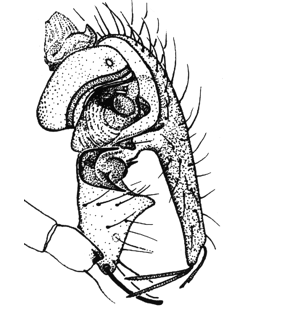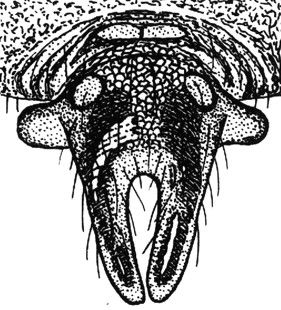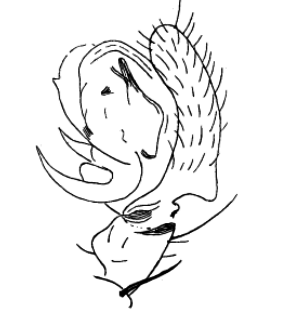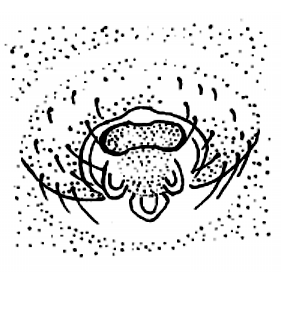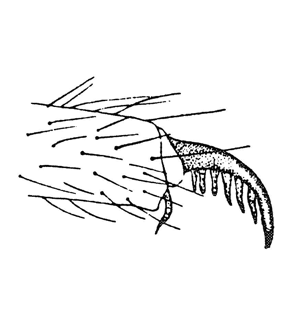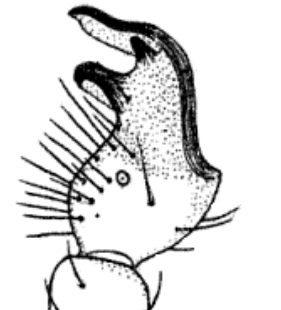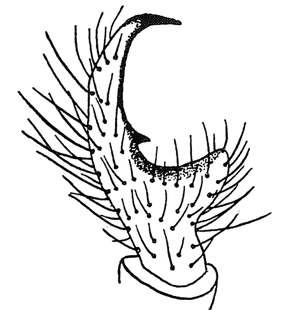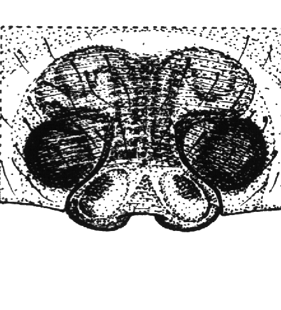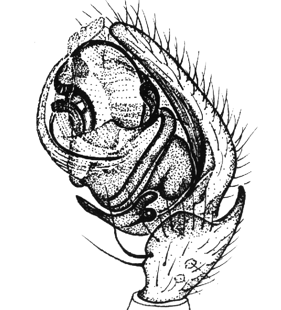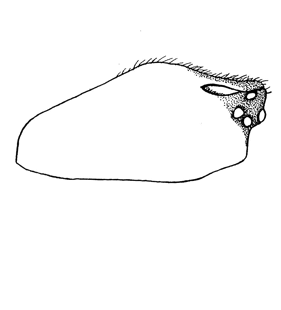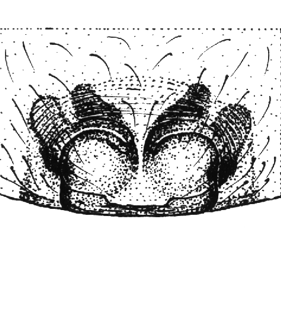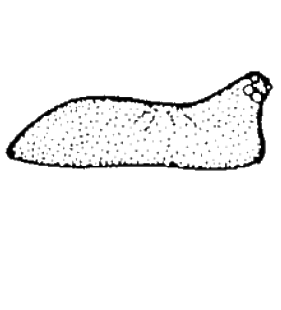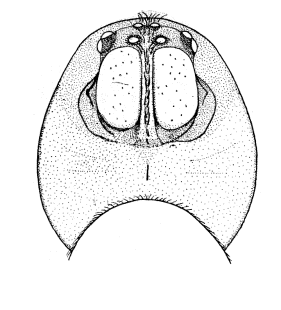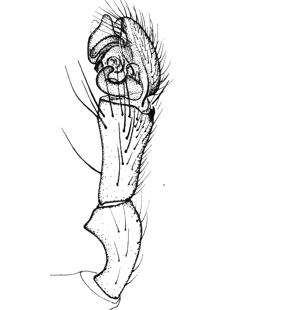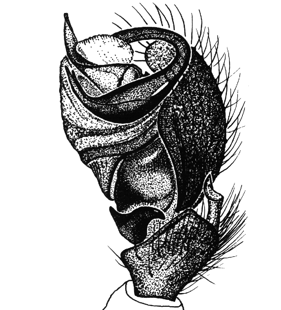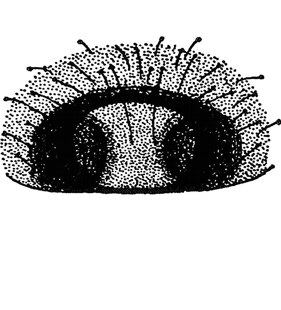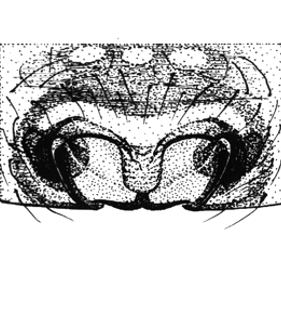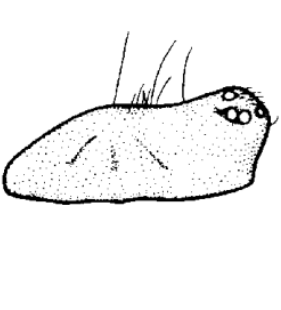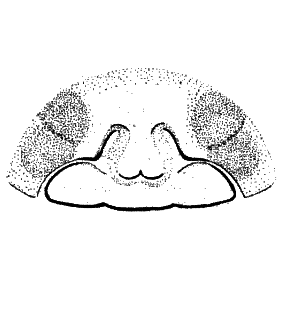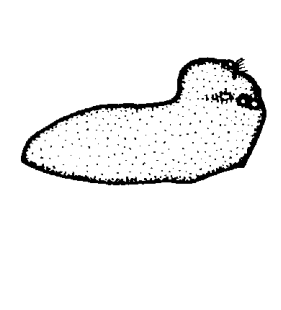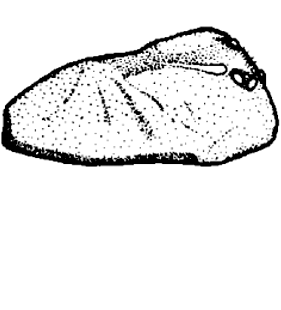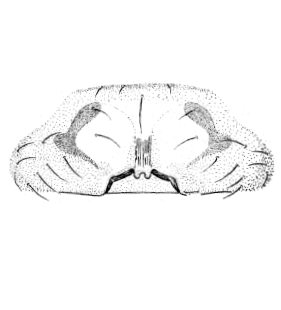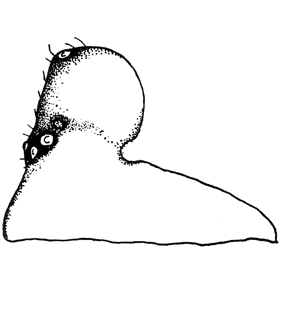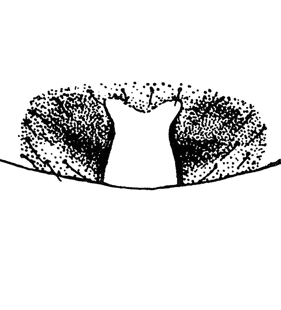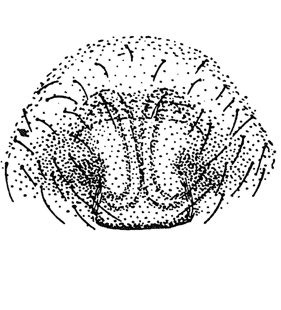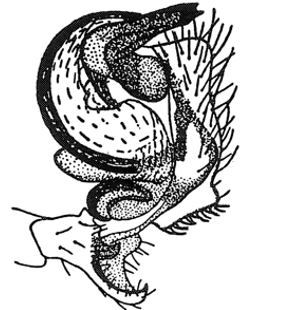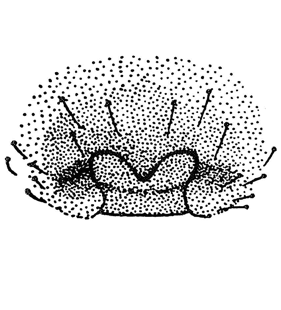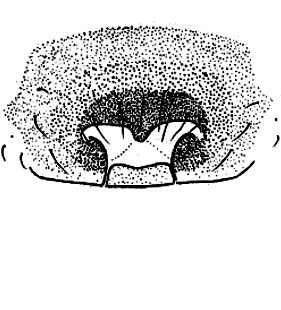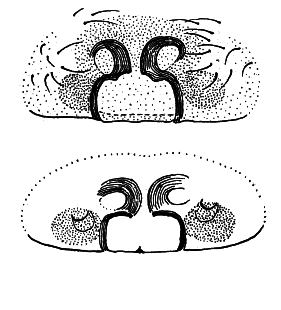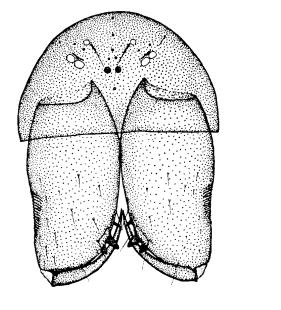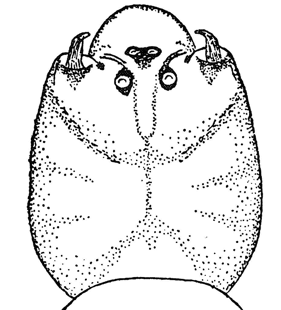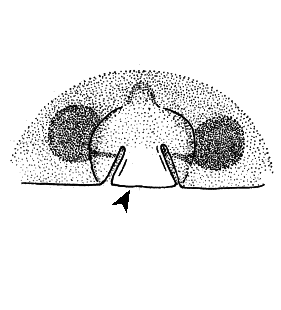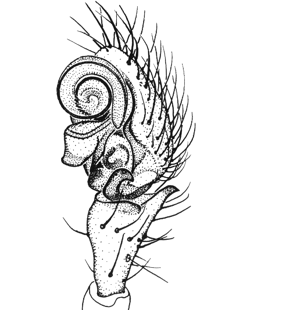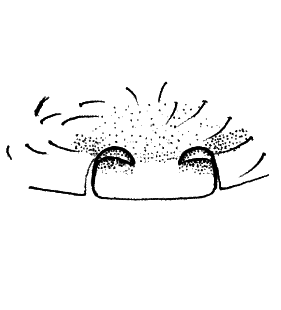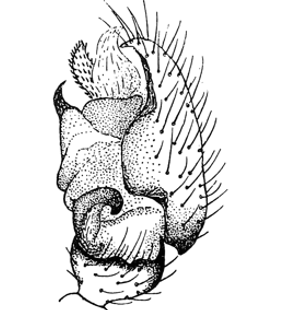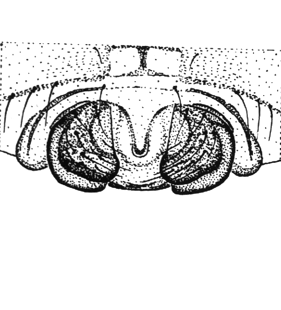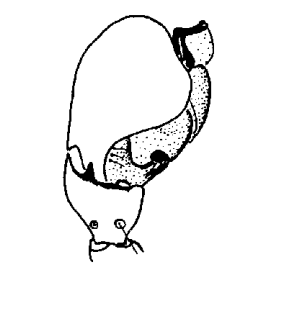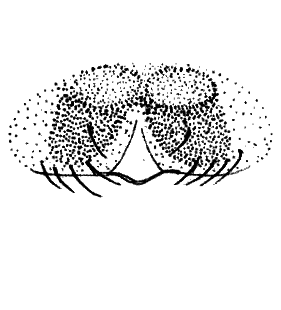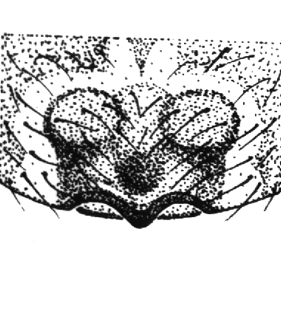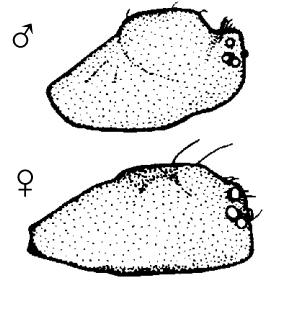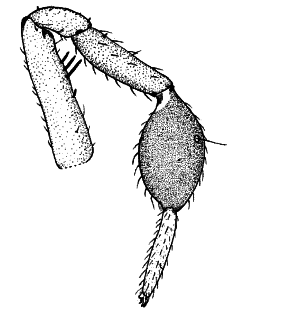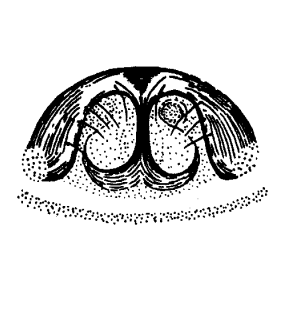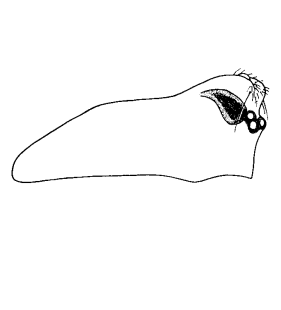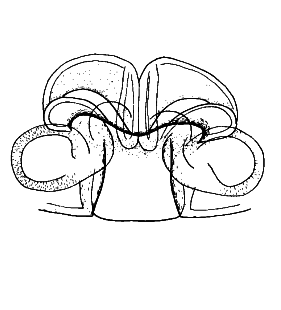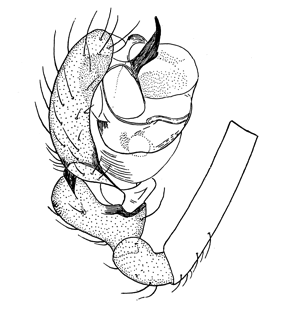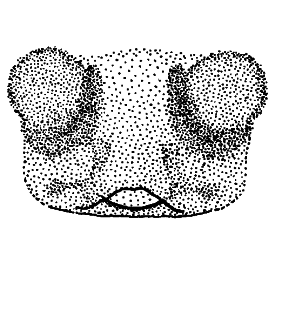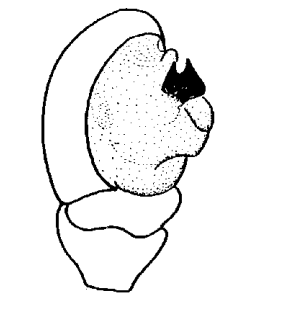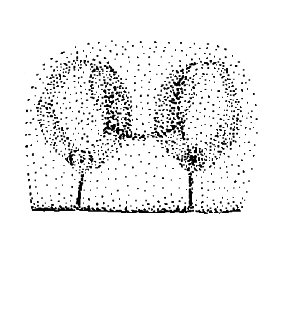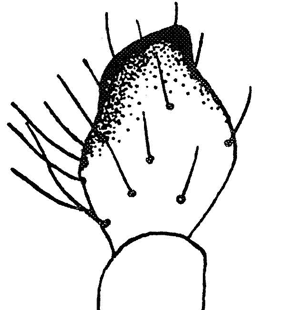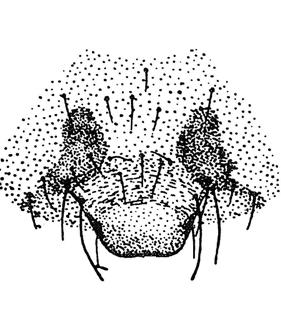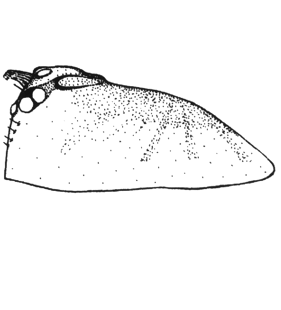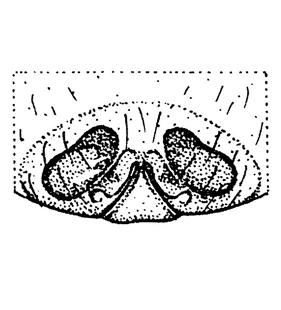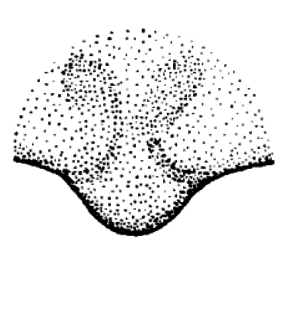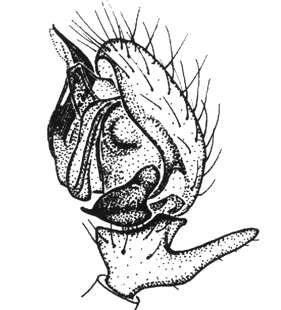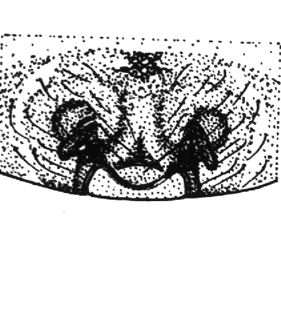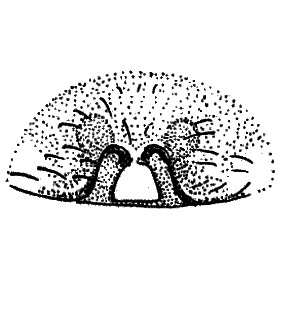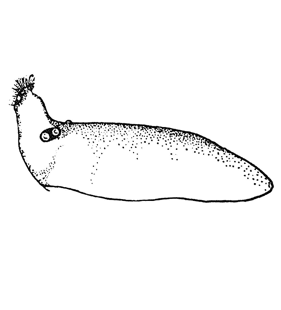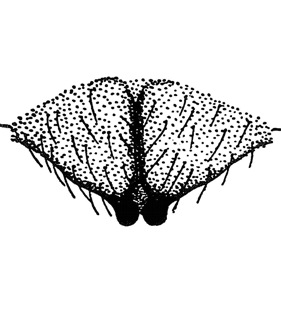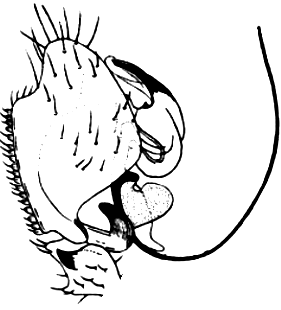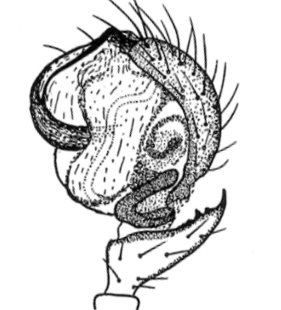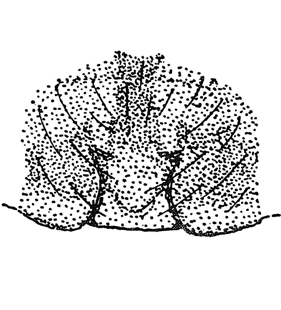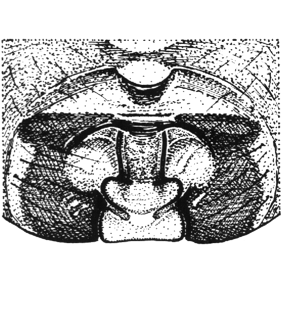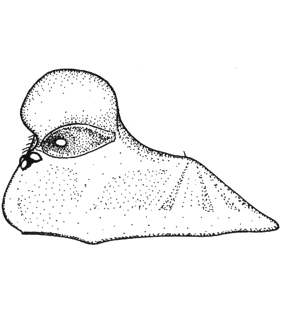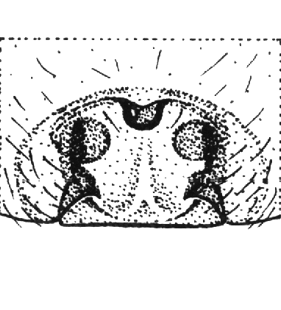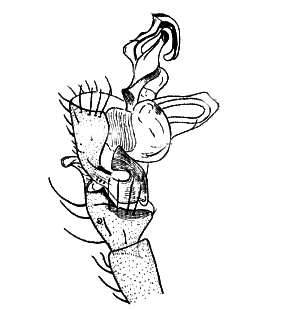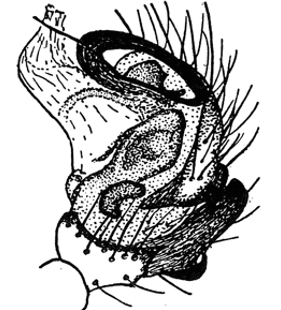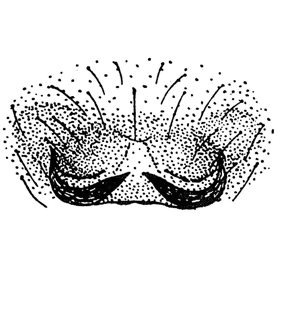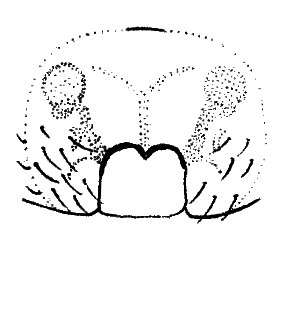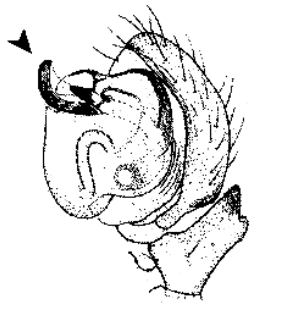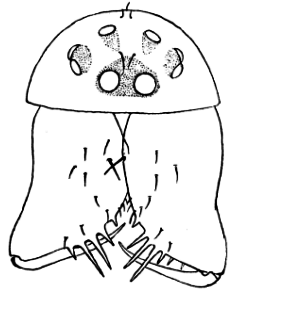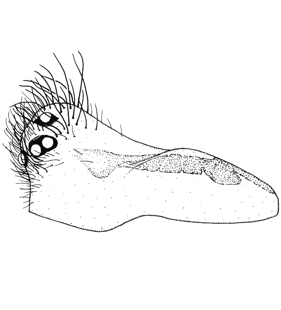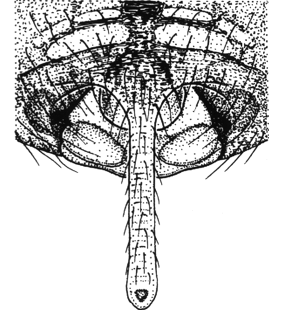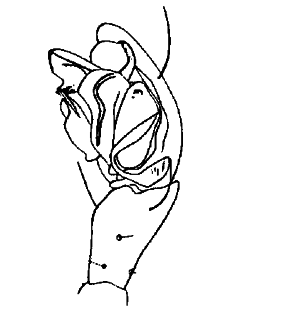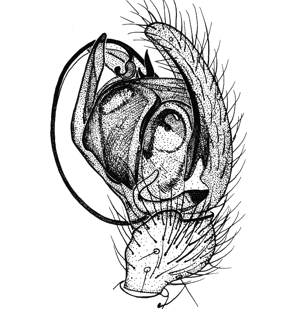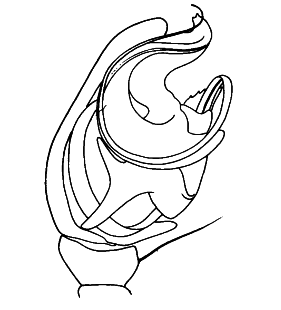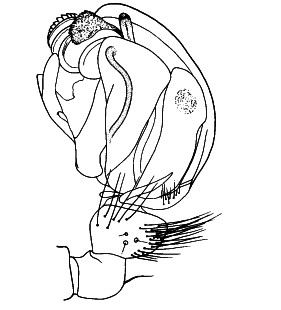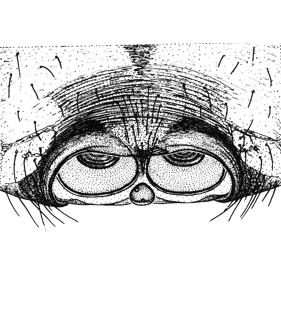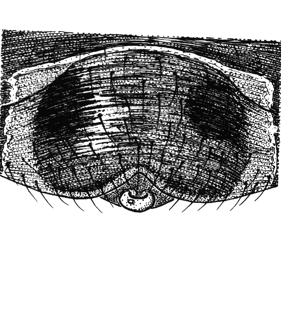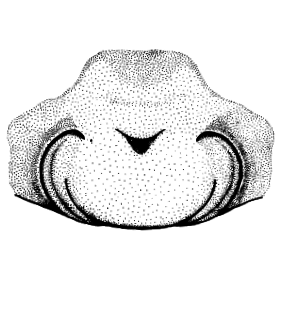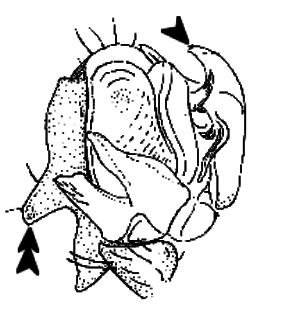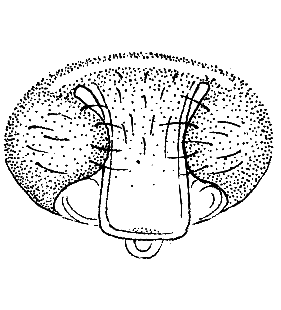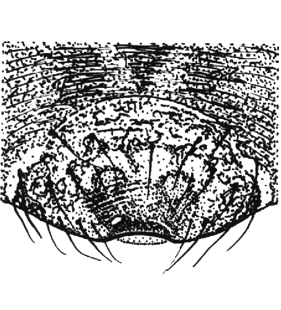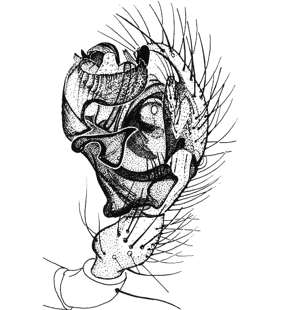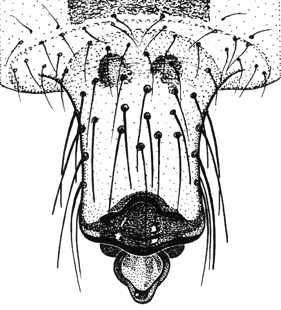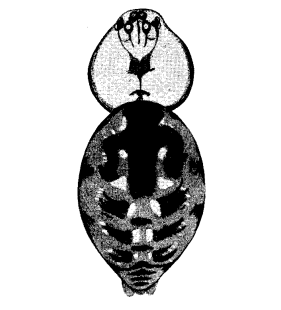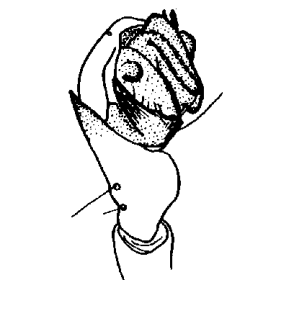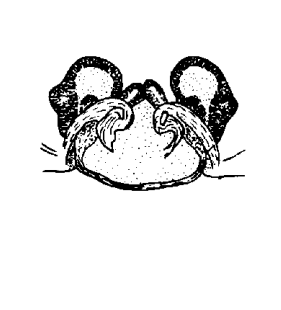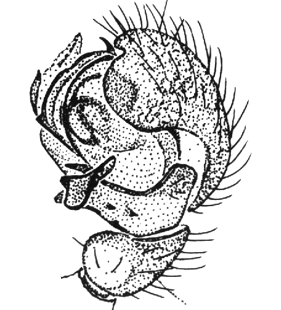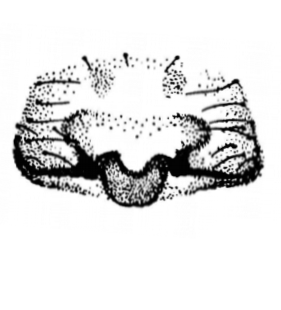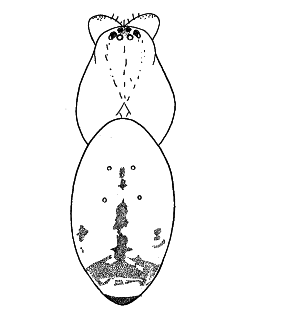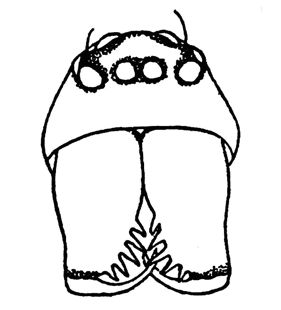Family Linyphiidae Blackwall, 1859
Key not complete! Further genera listed at the end of key |
In case you find an error or have a specific suggestion, please follow this link: click
|
|||||||
| 1 |
Tibia IV with one dorsal bristle
N.B.: This key to the linyphiid genera is based on Heimer & Nentwig (1991) and needs to be completely revised. An alternative online key to linyphiid species is provided by Anna Stäubli. |
|||||||
| - | Tibia IV with 2 dorsal bristles |
|||||||
| 2 (1) |
Metatarsus I with one dorsal bristle | |||||||
| - | Metatarsus I without dorsal bristle | |||||||
| 3 (2) |
Cymbium of male pedipalp with dorsal spur bearing stout bristles distally; epigyne backwardly elongated, deeply divided |
| ||||||
| - | Cymbium with small spur at most and without stout bristles |
| ||||||
| 4 (2) |
Tibia I-II ventrally with single, stout bristles in a double row, not row of bristles like in Hypselistes or Pocadicnemis | |||||||
| - | Tibia I-II ventrally without spines | |||||||
| 5 (4) |
Metatarsus IV dorsally with 1 trichobothrium | |||||||
| - | Metatarsus IV without trichobothria | |||||||
| 6 (5) |
Tibia and Metatarsus I-II ventrally with short, stout spines and long bristles respectively; prosoma ± unicoloured grey | |||||||
| - | Metatarsus I-II without ventral spines; Prosoma with distinct dark margin and median stripe |
| ||||||
| 7 (4) |
Metatarsus IV with trichobothria | |||||||
| - | Metatarsus IV without trichobothria | |||||||
| 8 (7) |
Trichobothrium on metatarsus I at 0.35-0.6 |
| ||||||
| - | Trichobothrium on metatarsus I > 0.6 | |||||||
| 9 (8) |
Trichobothrium on metatarsus I < 0.4 | |||||||
| - | Trichobothrium on metatarsus I at 0.4-0.6 | |||||||
| 10 (9) |
Prosoma length : width = 1.2-1.25; opisthosoma short and compact | |||||||
| - | Prosoma length : width = 1.4; opisthosoma longish | |||||||
| 11 (10) |
Opisthosoma dorsally leather-like, often with scuticula | |||||||
| - | Opisthosoma not leather-like, always with scuticula | |||||||
| 12 (10) |
Basal bristle on tibia I at < 0.15 | |||||||
| - | Basal bristle on tibia I at ± 0.2 | |||||||
| 13 (9) |
Paired tarsal claws with strikingly long comb-like teeth |
| ||||||
| - | Teeth of paired claws short or missing | |||||||
| 14 (13) |
Sternum densely provided with impressed dots | |||||||
| - | Sternum smooth | |||||||
| 15 (14) |
Trichobothrium at metatarsus I < 0.55 | |||||||
| - | Trichobothrium at metatarsus I at 0.6 | |||||||
| 16 (15) |
Tibia of male pedipalp with divided, bent apophysis and tufts of bristles; epigynal plate with longitudinal bulge |
| ||||||
| - | Male tibial apophysis undivided; epigyne different | |||||||
| 17 (16) |
Male pedipalp with large, bent tibia apophysis; male chelicerae anteriorly with protuberance; epigyne posteriorly with small recess |
| ||||||
| - | Male pedipalp with small, hook-shaped apophysis; epigyne as fig. |
| ||||||
| 18 (8) |
Trichobothrium on metatarsus I at 0.6-0.8 | |||||||
| - | Trichobothrium on metatarsus I > 0.8 | |||||||
| 19 (18) |
Head region in males with tower-like elevation, in females elevated |
| ||||||
| - | Different | |||||||
| 20 (19) |
Basal bristle on tibia I < 0.2 | |||||||
| - | Basal bristle on tibia I > 0.2 | |||||||
| 21 (20) |
Tibia I with one bristle | |||||||
| - | Tibia I with 2 bristles | |||||||
| 22 (21) |
Bristle on tibia I in males < diameter of tibia, in females > diameter of tibia; male prosoma as fig. |
| ||||||
| - | Male prosoma with bipartite cephalic lobe; tibial apophysis as fig.; bristle on tibia I in females < diameter of tibia |
| ||||||
| 23 (21) |
Male pedipalp with large dorsal apophysis bearing a rounded lateral branch; median part of epigyne approx. circularly extended anteriorly |
| ||||||
| - | Different | |||||||
| 24 (23) |
Bristle on tibia IV < diameter of tibia | |||||||
| - | Bristle on tibia IV > diameter of tibia | |||||||
| 25 (24) |
Tibia of male pedipalp >> cymbium; median epigynal part as fig. |
| ||||||
| - | Tibia of male pedipalp ≤ cymbium; median epigynal part different |
| ||||||
| 26 (24) |
Embolus short, robust and spiral; epigyne with lateral grooves |
| ||||||
| - | Different | |||||||
| 27 (26) |
Male pedipalp with robust, bent lateral tibial apophysis; median epigynal part twice as wide as long |
| ||||||
| - | Male pedipalp with one to several short dorsal tibial apophysis; median epigynal part ± as long as wide |
| ||||||
| 28 (18) |
Opisthosoma and legs with striking long hairs |
| ||||||
| - | Different | |||||||
| 29 (28) |
Dorsal line of prosoma posterior to head region distinctly depressed | |||||||
| - | Dorsal line of prosoma without depression | |||||||
| 30 (29) |
Male prosoma strongly elevated and laterally compressed; pedipalp as fig.; median epigynal part distinctly wider than long |
| ||||||
| - | Male prosoma elevated but without lateral depression; male pedipalp different; median epigynal part considerably longer than wide | |||||||
| 31 (29) |
Male prosoma with strongly haired and projecting "nose" or narrow cephalic lobe; receptaculum seminis comma like visible through epigyne; epigyne as fig. |
| ||||||
| - | Different | |||||||
| 32 (31) |
Bristle on tibia IV > 1.5 diameter of tibia | |||||||
| - | Bristle on tibia IV < 1.5 diameter of tibia | |||||||
| 33 (32) |
Bristle on tibia I at 0.25, on tibia IV at 0.35; male prosoma strongly elevated with deep groove in median part; epigyne as fig. |
| ||||||
| - | Bristle on tibia I at 0.15, on tibia IV < 0.25; male prosoma without groove; epigyne with X-shaped entrance ducts |
| ||||||
| 34 (32) |
Legs strikingly orange | |||||||
| - | Legs different | |||||||
| 35 (34) |
Ventral tibial bristles > diameter of tibia; embolus with broad membrane; median epigynal plate anteriorly bi-lobed or epigyne strongly sclerotised |
| ||||||
| - | Ventral tibial bristles < diameter of tibia, embolus different; tibia and patella thickened; epigyne different, e.g. as fig. |
| ||||||
| 36 (7) |
Tibia I dorsally with 1 or 2 bristles | |||||||
| - | Tibia I-II dorsally without bristles; tibia III-IV dorsally with one bristle | |||||||
| 37 (36) |
Tibia I-III with 2 bristles; tibia IV with one bristle | |||||||
| - | tibial bristles different | |||||||
| 38 (37) |
Trichobothria on metatarsus I at ≤ 0.4 | |||||||
| - | Trichobothria on metatarsus I at > 0.4 | |||||||
| 39 (38) |
Eyes very small, partly reduced |
| ||||||
| - | Eyes normally developed | |||||||
| 40 (39) |
Distance between posterior median eyes > 2 diameters, male prosoma laterally with horns, bearing bristles (compare also P. inconspicuus); median epigynal part square, trapezoid or a bit longer than wide |
| ||||||
| - | Distance between posterior median eyes smaller | |||||||
| 41 (40) |
Distance between posterior median eyes = diameter | |||||||
| - | Distance of posterior median eyes < diameter | |||||||
| 42 (41) |
Body length larger or equal 2.5 mm | |||||||
| - | Body length < 2.0 mm | |||||||
| 43 (42) |
Embolus long and spirally twisted; epigyne posteriorly with broad plate |
| ||||||
| - | Embolus short and straight; epigyne with distinct groove |
| ||||||
| 44 (41) |
Male pedipalp with very small tibial apophysis; median epigynal part small and triangular |
| ||||||
| - | Male pedipalp with large, mostly bent apophysis; median epigynal part elongated beyond epigastric furrow | |||||||
| 45 (38) |
Margin of prosoma and anterior side of chelicerae with robust teeth | |||||||
| - | Margin of prosoma different | |||||||
| 46 (45) |
Distance between posterior median eyes > diameter | |||||||
| - | Distance between posterior median eyes ≤ diameter | |||||||
| 47 (46) |
Distance between posterior median eyes > 2 diameters | |||||||
| - | Distance between posterior median eyes a bit more than its diameter | |||||||
| 48 (46) |
Male pedipalp with 2 short tibial apophysis; Epigyne with transverse oval receptaculum seminis, visible through epigyne, taking up almost whole width of epigyne |
| ||||||
| - | Different | |||||||
| 49 (48) |
Short embolus forming a loop next to distal parts of bulbus; epigyne width larger or equal its length |
| ||||||
| - | Embolus different; epigyne width < length | |||||||
| 50 (49) |
Prosoma posterior to eye region distinctly elevated but without lateral depressions |
| ||||||
| - | Different | |||||||
| 51 (50) |
Male metatarsus I strongly thickened; female prosoma anteriorly with distinct elevation; epigyne as fig. |
| ||||||
| - | Different | |||||||
| 52 (51) |
Male prosoma with bird-head-like process or forwardly protruding cephalic lobe with large lateral depressions; epigynal plate trapezoid |
| ||||||
| - | Different | |||||||
| 53 (52) |
Embolus very short and bent; tibial apophysis large, bent, broadly truncated; median epigynal part triangular posteriorly, tapering into a narrow stalk anteriorly |
| ||||||
| - | Embolus longer and twisted; tibial apophysis smaller; epigyne different |
| ||||||
| 54 (37) |
Tibia I-II with 2 bristles, tibia III-IV with one bristle | |||||||
| - | All tibiae with one bristle | |||||||
| 55 (54) |
Trichobothrium on metatarsus I at < 0.4 | |||||||
| - | Trichobothrium on metatarsus I at ≥ 0.4 | |||||||
| 56 (55) |
Prosoma and sternum with numerous impressed dots | |||||||
| - | Prosoma and sternum without impressed dots | |||||||
| 57 (56) |
Embolus long and band-shaped; epigyne with large groove, anteriorly bipartite or with chitinous wall | |||||||
| - | Embolus shorter; epigyne different | |||||||
| 58 (57) |
Male prosoma with lateral depressions; vulva with short, bent entrance ducts | |||||||
| - | Male prosoma without lateral depressions; entrance ducts very long and spirally twisted | |||||||
| 59 (57) |
Embolus very short; epigyne as fig. |
| ||||||
| - | Embolus longer, slightly bent or twisted; epigynal plate reaching beyond epigastric furrow | |||||||
| 60 (59) |
Male pedipalp without distinctly marked off tibial apophysis; epigyne as fig. |
| ||||||
| - | Male pedipalp different; epigyne different | |||||||
| 61 (55) |
Trichobothrium on metatarsus I at approx. 0.4 | |||||||
| - | Trichobothrium on metatarsus I at > 0.45 | |||||||
| 62 (61) |
Male prosoma laterally with a tuft of hairs on each side |
| ||||||
| - | Different | |||||||
| 63 (62) |
Embolus very long, spirally twisted; epigyne slit-like | |||||||
| - | Different | |||||||
| 64 (63) |
Distance between posterior median eyes > 2 diameters | |||||||
| - | Distance between posterior median eyes ± diameter | |||||||
| 65 (63) |
Male pedipalp with very small tibial apophysis; embolus relatively long; epigyne simple, reaching beyond epigastric furrow |
| ||||||
| - | Male pedipalp different; tibial apophysis large; embolus short and robust; epigyne complex, not reaching beyond epigastric furrow |
| ||||||
| 66 (61) |
Sternum with impressed dots | |||||||
| - | Sternum smooth | |||||||
| 67 (66) |
Trichobothrium on metatarsus I at ≥ 0.55; male prosoma posterior to eyes with deep depression; epigyne as fig. |
| ||||||
| - | Trichobothrium on metatarsus I at < 0.55; male prosoma and epigyne different | |||||||
| 68 (67) |
Male prosoma tower-like elevated in the area of anterior median eyes |
| ||||||
| - | Different | |||||||
| 69 (68) |
Basal bristle on tibia IV at < 0.15 | |||||||
| - | Basal bristle on tibia IV at ≥ 0.3 | |||||||
| 70 (54) |
Trichobothrium on metatarsus I at < 0.5 | |||||||
| - | Trichobothrium on metatarsus I at > 0.5 | |||||||
| 71 (70) |
Sternum with impressed dots | |||||||
| - | Sternum smooth | |||||||
| 72 (71) |
Bristle on tibia I at 0.2; cymbium with short row of bristles; embolus very long; epigyne with ± transverse oval plate |
| ||||||
| - | Bristle on tibia I at 0.1; cymbium different; embolus shorter; epigyne different | |||||||
| 73 (71) |
Tibia dark; male pedipalp with 2 short and one very long, sickle-shaped tibial apophysis; epigyne with distinct median epigynal plate, not strongly protruding towards posterior end |
| ||||||
| - | Different | |||||||
| 74 (73) |
Eyes of normal size; distance between posterior median eyes = diameter | |||||||
| - | Eyes very small; distance between posterior median eyes > 3 diameters | |||||||
| 75 (74) |
Bristle on tibia IV > diameter of tibia; male prosoma elevated and with lateral depression; epigyne reaching beyond epigastric furrow | |||||||
| - | Bristle on tibia IV < diameter of tibia; male prosoma different; epigyne not reaching beyond epigastric furrow | |||||||
| 76 (70) |
Trichobothrium on metatarsus I at 0.5-0.65 | |||||||
| - | Trichobothrium on metatarsus I at > 0.7 | |||||||
| 77 (76) |
Clypeus nose-like protruding, in females less pronounced; epigyne with strongly sclerotised, triangular plate | |||||||
| - | Different | |||||||
| 78 (77) |
Prosoma dorsally with radial rows of impressed dots; opisthosoma with dorsal scuticula (in females often missing) | |||||||
| - | Prosoma without impressed dots | |||||||
| 79 (78) |
Male pedipalp with broad, band-shaped embolus; median epigynal part distinctly divided into anterior and posterior plate; receptaculum seminis at each side of posterior plate |
| ||||||
| - | Different | |||||||
| 80 (79) |
Male head region elevated; anterior epigynal margin with small pocket |
| ||||||
| - | Different | |||||||
| 81 (80) |
Median epigynal part wider than long; male pedipalp with long apophysis | |||||||
| - | Eyes large; distance between posterior median eyes ≤ 2 diameters; male pedipalp with short tibial apophysis; length of median epigynal part ≥ its width | |||||||
| 82 (81) |
Male pedipalp and epigyne as fig. |
| ||||||
| - | Male pedipalp as fig.; posterior epigynal margin with 2 sclerotised arcs |
| ||||||
| 83 (81) |
Embolus very long and thin; anterior epigynal margin indented |
| ||||||
| - | Embolus short and thick; epigyne different |
| ||||||
| 84 (76) |
Legs and prosoma dark orange; body length > 2 mm | |||||||
| - | Legs and prosoma different in colour; body length < 2 mm | |||||||
| 85 (1) |
Tibia I with one or several lateral bristles | |||||||
| - | Tibia I without lateral bristles | |||||||
| 86 (85) |
Legs long and thin; femur I and IV mostly > prosoma; length of tibia I = 10 diameters | |||||||
| - | Legs shorter and stouter; femur I and IV < prosoma; length of tibia I at most 7 diameters | |||||||
| 87 (86) |
Anterior cheliceral furrow margin with 5-6 long, robust denticles | |||||||
| - | Anterior cheliceral furrow margin with 4 small denticles at most | |||||||
| 88 (87) |
Anterior side of chelicera with 3-4 robust bristles |
| ||||||
| - | Anterior side of chelicera without bristles | |||||||
| 89 (88) |
Clypeus not higher than diameter of anterior median eyes; anterior cheliceral furrow margin with 3 long and 2 shorter denticles |
| ||||||
| - | Clypeus higher than diameter of anterior median eyes; anterior cheliceral furrow margin with 5 equally long, robust denticles; opisthosoma bulged |
| ||||||
| 90 (87) |
Metatarsus without bristles | |||||||
| - | At least metatarsus I with dorsal bristle | |||||||
| 91 (90) |
Male pedipalp considerably longer than wide; epigyne with very long scapus |
| ||||||
| - | Different | |||||||
| 92 (91) |
Femur I-II with dorsal spines; femur III and IV without spines | |||||||
| - | Spines on femora different or femur without dorsal spines | |||||||
| 93 (90) |
Distance between posterior median eyes and posterior lateral eyes < 0.5 diameter of posterior median eyes | |||||||
| - | Distance between posterior median eyes and posterior lateral eyes > 0.5 diameter of posterior median eyes | |||||||
| 94 (93) |
Legs with small, sharply margined spots; femur ventrally spotted with black (not annulated); prosoma with broad, black Y-shaped pattern | |||||||
| - | Legs with different pattern; femur ventrally without black spots; Y-like pattern on prosoma indistinct or missing | |||||||
| 95 (94) |
Opisthosoma ventrally with sharply margined white spots anterior to spinnerets | |||||||
| - | Different | |||||||
| 96 (95) |
Distance between anterior median eyes ≥ diameter; opisthosoma with grey markings | |||||||
| - | Distance between anterior median eyes < diameter; opisthosoma different | |||||||
| 97 (96) |
Paracymbium complex; epigyne complex, reaching beyond epigastric furrow and / or folded scapus | |||||||
| - | Paracymbium simple; epigyne simple; scapus not folded or missing | |||||||
| 98 (97) |
Male pedipalp with long embolus; terminal part hair-like; epigyne very small or covered or distinctly divided into two parts by median septum |
| ||||||
| - | Embolus short, terminal part not hair-like; epigyne with a large, undivided depression |
| ||||||
| 99 (98) |
Terminal part of embolus covered by a membrane; epigyne with a large, bipartite groove |
| ||||||
| - | Embolus almost entirely visible, epigynal groove very small, triangular or covered | |||||||
| 100 (99) |
The posterior median eyes with broad, black rings; femur with spines; male opisthosoma dorsally on 1/5 of its length with bright white spots; tip of embolus a long, free loop; paracymbium small; epigynal groove very small, triangular with very small scapus or with 2 small epigynal grooves, separated by a short, broad scapus |
| ||||||
| - | The posterior median eyes with narrow, black rings; femur without spines; embolus not a long, free loop; paracymbium as long as wide; epigynal area swollen, with slit-like openings |
| ||||||
| 101 (97) |
Head region in males and females forwardly elongated, bristled | |||||||
| - | Head region different | |||||||
| 102 (101) |
Femur I with dorsal bristles | |||||||
| - | Femur I without dorsal bristles | |||||||
| 103 (102) |
Gnathocoxae longer than width of its base | |||||||
| - | Gnathocoxae as long as wide | |||||||
| 104 (102) |
Embolus very short; scapus folded (Additional remark: compare also Troglohyphantes lucifugus) |
|||||||
| - | Embolus long scapus not folded; epigyne reaching beyond epigastric furrow | |||||||
| 105 (104) |
Tibia IV distally with bristle; opisthosoma without spots | |||||||
| - | Tibia IV distally without bristles; opisthosoma with dark spots (maybe indistinct) | |||||||
| 106 (86) |
Metatarsus IV with trichobothria | |||||||
| - | Metatarsus IV without trichobothria | |||||||
| 107 (106) |
Trichobothrium on metatarsus I at 0.55 | |||||||
| - | Trichobothrium on metatarsus I at > 0.55 | |||||||
| 108 (107) |
Distance between posterior eyes < diameter; length of basal bristle on tibia IV = 1.5 diameter of tibia I | |||||||
| - | Distance between posterior eyes > diameter; length of basal bristle on tibia IV greater or equal 2 diameters of tibia I | |||||||
| 109 (106) |
Trichobothrium on metatarsus I at 0.25 | |||||||
| - | Trichobothrium on metatarsus I at ≥ 0.3 | |||||||
| 110 (109) |
Coxae IV separated by more than their diameter; cymbium of male pedipalp with square-edged protrusions; epigyne at most 1.5x as wide as long; epigynal median plate with parallel sides |
| ||||||
| - | Coxae IV separated by less than their diameter; male pedipalp different; epigyne approx. twice as wide as long Meioneta |
|||||||
| 111 (109) |
Trichobothrium on metatarsus I at 0.3-0.4 | |||||||
| - | Trichobothrium on metatarsus I at ≥ 0.5 | |||||||
| 112 (111) |
Tibia I laterally anteriorly and posteriorly with bristle | |||||||
| - | Tibia I only laterally anteriorly with bristle | |||||||
| 113 (112) |
Male pedipalp with ± square paracymbium and distinct, small embolus; epigyne simple and without scapus |
| ||||||
| - | Male pedipalp different; epigyne with scapus |
| ||||||
| - | Male pedipalp different; epigyne with scapus |
| ||||||
| 114 (85) |
Length of femur I ± length of prosoma; length of metatarsus I = length of tibia I; opisthosoma with striking black and white pattern |
| ||||||
| - | Different | |||||||
| 115 (114) |
Metatarsus IV with trichobothria | |||||||
| - | Metatarsus IV without trichobothria | |||||||
| 116 (115) |
Trichobothrium on metatarsus I at < 0.7 | |||||||
| - | Trichobothrium on metatarsus I at > 0.7 | |||||||
| 117 (116) |
Dorsal line of prosoma posterior to eyes deeply depressed; length of basal bristle on tibia I = diameter of tibia I | |||||||
| - | Dorsal line straight; basal bristle on tibia I longer | |||||||
| 118 (117) |
Basal bristle on tibia I approx. 1.5 diameter of tibia I; male pedipalp with long tibial apophysis; epigyne as fig. |
| ||||||
| - | Basal bristle on tibia I longer or equal 2 diameter of tibia I; tibial apophysis of male pedipalp different or missing; epigyne different | |||||||
| 119 (118) |
Diameter of posterior median eyes > diameter of posterior lateral eyes; male pedipalp without tibial apophysis; epigyne as fig. |
| ||||||
| - | Diameter of posterior median eyes = diameter of posterior lateral eyes; male pedipalp with small tibial apophysis; epigyne different |
| ||||||
| 120 (116) |
Body length smaller or equal 2.5 mm; trichobothria of metatarsi mostly bent or angled | |||||||
| - | Body length > 3.5 mm; trichobothria of metatarsi always straight | |||||||
| 121 (120) |
Colouration light; opisthosoma with dark pattern (maybe indistinct); diameter of anterior lateral eyes = diameter of anterior median eyes |
| ||||||
| - | Colouration dark; opisthosoma unicoloured; diameter of anterior lateral eyes = 2 diameter of anterior median eyes |
| ||||||
| 122 (115) |
Striking yellowish red colouration; around spinnerets black; male pedipalp and epigyne as fig. |
| ||||||
| - | Different | |||||||
| 123 (122) |
Metatarsus I-III with dorsal bristle | |||||||
| - | Metatarsus I-III without dorsal bristle | |||||||
| 124 (123) |
Posterior eyes very large, touching each other; tarsus with dorsal bristle Meioneta |
|||||||
| - | Posterior eyes small, distinctly separated; tarsus without bristle | |||||||
| 125 (123) |
Trichobothrium on metatarsus I at 0.25 Meioneta |
|||||||
| - | Trichobothrium on metatarsus I at 0.35-0.5 | |||||||
| 126 (125) |
Body length > 2.5 mm; length of tarsus I < length of metatarsus I | |||||||
| - | Body length < 1.6 mm; length of tarsus I = length of metatarsus I |
Further genera
- 1. Abiskoa
- 2. Agnyphantes
- 3. Alioranus
- 4. Allotiso
- 5. Anguliphantes
- 6. Antrohyphantes
- 7. Archaraeoncus
- 8. Arcterigone
- 9. Birgerius
- 10. Bisetifer
- 11. Bolephthyphantes
- 12. Bordea
- 13. Brachycerasphora
- 14. Callitrichia
- 15. Canariphantes
- 16. Caucasopisthes
- 17. Centrophantes
- 18. Ceraticelus
- 19. Cherserigone
- 20. Cresmatoneta
- 21. Crosbyarachne
- 22. Dactylopisthes
- 23. Decipiphantes
- 24. Diastanillus
- 25. Didectoprocnemis
- 26. Dresconella
- 27. Estrandia
- 28. Fageiella
- 29. Flagelliphantes
- 30. Formiphantes
- 31. Gibothorax
- 32. Heterotrichoncus
- 33. Horcotes
- 34. Hybauchenidium
- 35. Hybocoptus
- 36. Iberoneta
- 37. Icariella
- 38. Improphantes
- 39. Incestophantes
- 40. Ipa
- 41. Islandiana
- 42. Janetschekia
- 43. Karita
- 44. Kikimora
- 45. Kratochviliella
- 46. Maculoncus
- 47. Mansuphantes
- 48. Masikia
- 49. Megalepthyphantes
- 50. Mermessus
- 51. Mesasigone
- 52. Midia
- 53. Moebelia
- 54. Monocephalus
- 55. Monocerellus
- 56. Mughiphantes
- 57. Mycula
- 58. Nematogmus
- 59. Nothophantes
- 60. Nusoncus
- 61. Obscuriphantes
- 62. Oreoneta
- 63. Oryphantes
- 64. Ouedia
- 65. Palliduphantes
- 66. Paraglyphesis
- 67. Parapelecopsis
- 68. Pecado
- 69. Perregrinus
- 70. Perro
- 71. Piniphantes
- 72. Plaesianillus
- 73. Plesiophantes
- 74. Praestigia
- 75. Prinerigone
- 76. Proislandiana
- 77. Pseudocarorita
- 78. Pseudocyba
- 79. Russocampus
- 80. Sauron
- 81. Scandichrestus
- 82. Scotargus
- 83. Scutpelecopsis
- 84. Sengletus
- 85. Silometopoides
- 86. Sisicus
- 87. Staveleya
- 88. Tallusia
- 89. Tanasevitchia
- 90. Tarsiphantes
- 91. Tenuiphantes
- 92. Thaleria
- 93. Thaumatoncus
- 94. Tibiaster
- 95. Tibioploides
- 96. Tibioplus
- 97. Trichoncoides
- 98. Trichoncyboides
- 99. Trichopternoides
- 100. Troxochrota
- 101. Tubercithorax
- 102. Turinyphia
- 103. Typhlonyphia
- 104. Uralophantes
- 105. Viktorium
- 106. Wabasso
- 107. Walckenaerianus
- 108. Wiehlea
- 109. Wiehlenarius
- 110. Wubanoides
- 111. Zornella
